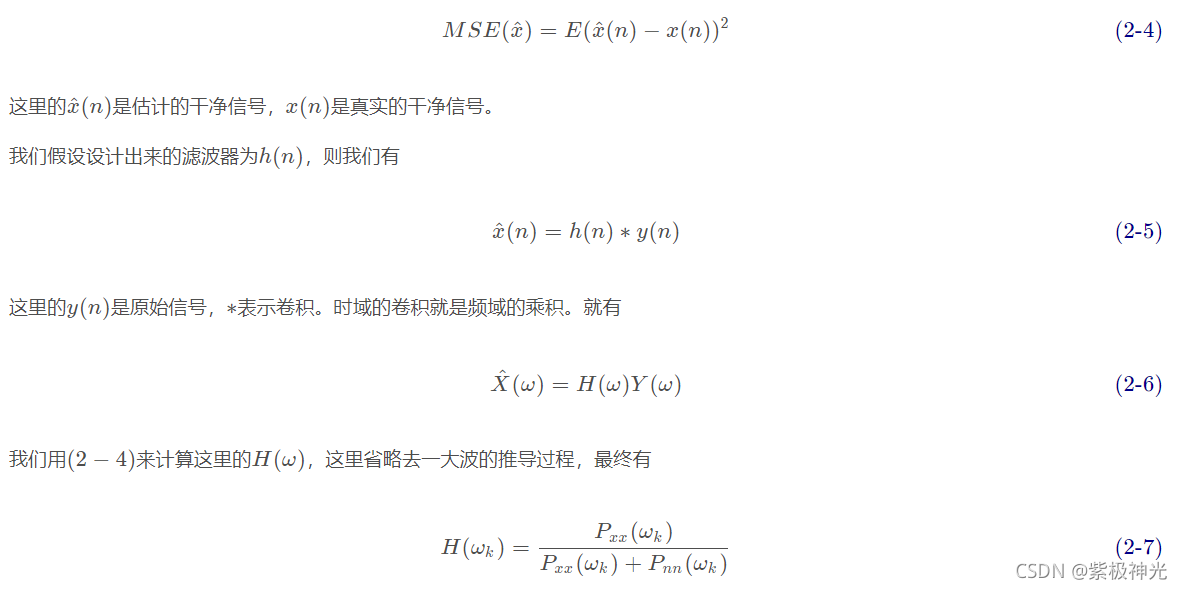【语音去噪】基于matlab GUI谱减法+维纳滤波语音去噪(带面板+信噪比)【含Matlab源码 1661期】
一、简介
1 维纳滤波法
维纳滤波法(wiener filter)也是一个比较经典的传统做法,它的本质是估计出一个线性滤波器,也就是一个向量,这个滤波器会对不同的频段进行不同程度的抑制,其保真效果会比谱减法要好一些。
我们这里不会讲详细的推导过程,只讲其大致思想。因为这么大功夫推导出来,还是有很多不能解决的问题,还不如深度学习train一发。想看详细推导了可以去看知乎的卡尔曼滤波器详解——从零开始(3) Kalman Filter from Zero这篇,于泓-语音增强-维纳滤波这个视频讲的更偏向于应用,都很棒。
还有就是这里讲的是smoothing的问题,即根据未来的信号,过去的信号以及现在的信号来推测出现在的干净信号。除此之外,还有prediction和filtering的问题,prediction是指根据过去的和现在的信号,预测未来的干净信号;filtering的问题是指根据过去和现在的信号,推测现在的干净信号。所以这里讲的方法没法应用于实时语音去噪,只能在拿到整段信号之后,对这段信号进行去噪。
维纳滤波器的设计准则为使得干净信号x(n)x(n)和估计的干净信号x ^ ( n ) 之间的差值越小越好,即计算一个最小均方差


2 谱减法
应该是最早被用于语音去噪的方法,它的思想非常简单,就是通过估计出噪声,并在频域里将其幅值剪掉,再还原,就结束了。为了表示方便,我们先假设纯净的声音为x(n),原始声音为y(n),噪声为e(x),就有y(n)=x(n)+e(n)
这里只有y(n)是我们有的,其他x(n)和e(n)都还不知道,目的是把x(n)给求出来。
noisereduce中的stationary的方法就是用谱减法去做的,效果还是不错的,不过也只能应对于stationary noise。
我们按谱减法步骤来说明一下整个过程。
(1)截取头部一小段语音作为噪声
e(m)=y(n)[:m]
其中e表示噪声信号,y表示原始信号,m和n表示sample的数量。
我们认为stationary noise是一直存在于背景当中的声音,而人声一般在开头的几十毫秒是没有的,所以就默认取前面一小段作为噪声。不过当无法确定噪声的时候,把整段声音都作为噪声也是可以的,noisereduce就是这么做的。
(2)分别计算原始音频和噪声的STFT,Y(ω)和E(ω)。
(3)根据噪声的频谱幅值,对原始音频的频谱幅值进行谱减。

这样做不好的地方就是会有很多坑坑洼洼的噪声频率残留,这个现象也被称为是音乐噪声。实际操作过会发现这种方法减了和没减差不多。因此有人提出了过减法,就是宁可错杀一千不能放过一个的做法。

其中,α∈[0,+∞]是过减因子,β∈[0,1]是谱下限参数,用来控制残留多少的噪声。这样减出来噪声会明显少了很多,但声音也会随着α \alphaα的增大而逐渐失真。
noisereduce中的具体实现略有不同,它过减用∣E(ω)∣的方差来控制,一般是1.5倍或者1.0倍的方差。代码片段如下所示
self.mean_freq_noise = np.mean(noise_stft_db, axis=1)
self.std_freq_noise = np.std(noise_stft_db, axis=1)
self.noise_thresh = self.mean_freq_noise + self.std_freq_noise * self.n_std_thresh_stationary
- 1
- 2
- 3
小于noise_thresh的幅值会置0,其余的保留。n_std_thresh_stationary为0时,就是没有过减的式(2−2)。
(4)对∣ X ^ ( ω ) ∣做平滑处理,使得声音失真没那么严重。
noisereduce中使用的scipy.signal.fftconvolve来实现这一过程。
(5)结合原始音频的相位,还原谱减后的音频。这就是个反向STFT的过程。
二、部分源代码
% algorithm_flag = 0;
function varargout = gui(varargin)
% GUI MATLAB code for gui.fig
% GUI, by itself, creates a new GUI or raises the existing
% singleton*.
%
% H = GUI returns the handle to a new GUI or the handle to
% the existing singleton*.
%
% GUI('CALLBACK',hObject,eventData,handles,...) calls the local
% function named CALLBACK in GUI.M with the given input arguments.
%
% GUI('Property','Value',...) creates a new GUI or raises the
% existing singleton*. Starting from the left, property value pairs are
% applied to the GUI before gui_OpeningFcn gets called. An
% unrecognized property name or invalid value makes property application
% stop. All inputs are passed to gui_OpeningFcn via varargin.
%
% *See GUI Options on GUIDE's Tools menu. Choose "GUI allows only one
% instance to run (singleton)".
%
% See also: GUIDE, GUIDATA, GUIHANDLES
% Edit the above text to modify the response to help gui
% Last Modified by GUIDE v2.5 06-Apr-2021 19:48:53
% Begin initialization code - DO NOT EDIT
gui_Singleton = 1;
gui_State = struct('gui_Name', mfilename, ...
'gui_Singleton', gui_Singleton, ...
'gui_OpeningFcn', @gui_OpeningFcn, ...
'gui_OutputFcn', @gui_OutputFcn, ...
'gui_LayoutFcn', [] , ...
'gui_Callback', []);
if nargin && ischar(varargin{1})
gui_State.gui_Callback = str2func(varargin{1});
end
if nargout
[varargout{1:nargout}] = gui_mainfcn(gui_State, varargin{:});
else
gui_mainfcn(gui_State, varargin{:});
end
% End initialization code - DO NOT EDIT
% --- Executes just before gui is made visible.
function gui_OpeningFcn(hObject, eventdata, handles, varargin)
% This function has no output args, see OutputFcn.
% hObject handle to figure
% eventdata reserved - to be defined in a future version of MATLAB
% handles structure with handles and user data (see GUIDATA)
% varargin command line arguments to gui (see VARARGIN)
% Choose default command line output for gui
handles.output = hObject;
% Update handles structure
guidata(hObject, handles);
% UIWAIT makes gui wait for user response (see UIRESUME)
% uiwait(handles.figure1);
% --- Outputs from this function are returned to the command line.
function varargout = gui_OutputFcn(hObject, eventdata, handles)
% varargout cell array for returning output args (see VARARGOUT);
% hObject handle to figure
% eventdata reserved - to be defined in a future version of MATLAB
% handles structure with handles and user data (see GUIDATA)
% Get default command line output from handles structure
varargout{1} = handles.output;
%算法1
function pushbutton1_Callback(hObject, eventdata, handles)
set(handles.text6, 'String','谱减法');
%谱减法语音降噪
global filename;
[xx, fs] = audioread(filename); % 读入数据文件 样本数据 xx 该数据的采样率 Fs。
xx=xx-mean(xx); % 消除直流分量
global x;
x=xx/max(abs(xx)); % 幅值归一化 abs 数据绝对值
IS=0.25; % 设置前导无话段长度
wlen=200; % 设置帧长为25ms
inc=80; % 设置帧移为10ms
global SNR;
%SNR=5; % 设置信噪比SNR
N=length(x); % 信号长度
global signal
signal=awgn(x,SNR,'measured','db'); % 叠加噪声
global snr1;
global snr2;
snr1=SNR_Calc(x,signal); % 计算初始信噪比
NIS=fix((IS*fs-wlen)/inc +1); % 求前导无话段帧数
a=4; b=0.001; % 设置参数a和b
global output;
output=SpectralSub(signal,wlen,inc,NIS,a,b);% 谱减
snr2=SNR_Calc(x,output); % 计算谱减后的信噪比
snr=snr2-snr1;
fprintf('snr1=%5.4f snr2=%5.4f snr=%5.4f\n',snr1,snr2,snr);
% %显示图片
% handles.x = x;
% axes(handles.axes1);
% plot(handles.x);
% handles.signal = signal;
% axes(handles.axes2);
% plot(handles.signal);
% handles.output = output;
% axes(handles.axes3);
% plot(handles.output);
%算法2
function pushbutton2_Callback(hObject, eventdata, handles)
set(handles.text6, 'String','维纳滤波');
%基于先验信噪比的维纳滤波算法语音降噪
global filename;
[xx, fs] = audioread(filename); % 读入数据文件
xx=xx-mean(xx); % 消除直流分量
global x;
x=xx/max(abs(xx)); % 幅值归一化
IS=0.25; % 设置前导无话段长度
wlen=200; % 设置帧长为25ms
inc=80; % 设置帧移为10ms
global SNR;
%SNR=5; % 设置信噪比SNR
NIS=fix((IS*fs-wlen)/inc +1); % 求前导无话段帧数
alpha=0.95;
global signal;
signal=awgn(x,SNR,'measured','db'); % 叠加噪声
global output;
output=Weina_Im(x,wlen,inc,NIS,alpha) ;
output=output/max(abs(output));
len=min(length(output),length(x));
x=x(1:len);
signal=signal(1:len);
output=output(1:len);
global snr1;
global snr2;
snr1=SNR_Calc(x,signal); % 计算初始信噪比
snr2=SNR_Calc(x,output); % 计算降噪后的信噪比
snr=snr2-snr1;
fprintf('snr1=%5.4f snr2=%5.4f snr=%5.4f\n',snr1,snr2,snr);
% %显示图片
% handles.x = x;
% axes(handles.axes1);
% plot(handles.x);
% handles.signal = signal;
% axes(handles.axes2);
% plot(handles.signal);
% handles.output = output;
% axes(handles.axes3);
% plot(handles.output);
- 1
- 2
- 3
- 4
- 5
- 6
- 7
- 8
- 9
- 10
- 11
- 12
- 13
- 14
- 15
- 16
- 17
- 18
- 19
- 20
- 21
- 22
- 23
- 24
- 25
- 26
- 27
- 28
- 29
- 30
- 31
- 32
- 33
- 34
- 35
- 36
- 37
- 38
- 39
- 40
- 41
- 42
- 43
- 44
- 45
- 46
- 47
- 48
- 49
- 50
- 51
- 52
- 53
- 54
- 55
- 56
- 57
- 58
- 59
- 60
- 61
- 62
- 63
- 64
- 65
- 66
- 67
- 68
- 69
- 70
- 71
- 72
- 73
- 74
- 75
- 76
- 77
- 78
- 79
- 80
- 81
- 82
- 83
- 84
- 85
- 86
- 87
- 88
- 89
- 90
- 91
- 92
- 93
- 94
- 95
- 96
- 97
- 98
- 99
- 100
- 101
- 102
- 103
- 104
- 105
- 106
- 107
- 108
- 109
- 110
- 111
- 112
- 113
- 114
- 115
- 116
- 117
- 118
- 119
- 120
- 121
- 122
- 123
- 124
- 125
- 126
- 127
- 128
- 129
- 130
- 131
- 132
- 133
- 134
- 135
- 136
- 137
- 138
- 139
- 140
- 141
- 142
- 143
- 144
- 145
- 146
- 147
- 148
- 149
- 150
- 151
- 152
- 153
- 154
- 155
- 156
- 157
- 158
- 159
- 160
- 161
- 162
三、运行结果


四、matlab版本及参考文献
1 matlab版本
2014a
2 参考文献
[1]韩纪庆,张磊,郑铁然.语音信号处理(第3版)[M].清华大学出版社,2019.
[2]柳若边.深度学习:语音识别技术实践[M].清华大学出版社,2019.
文章来源: qq912100926.blog.csdn.net,作者:海神之光,版权归原作者所有,如需转载,请联系作者。
原文链接:qq912100926.blog.csdn.net/article/details/122372786
- 点赞
- 收藏
- 关注作者


评论(0)